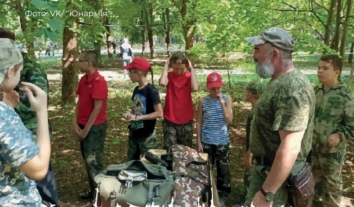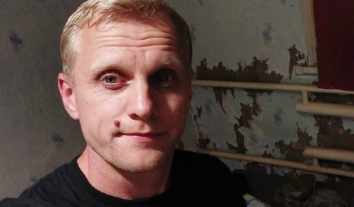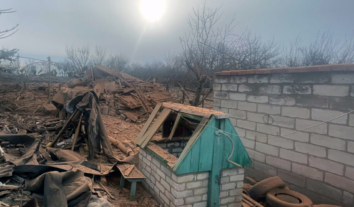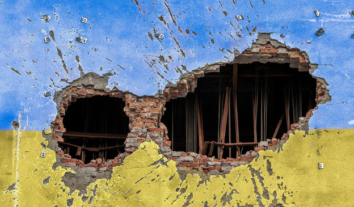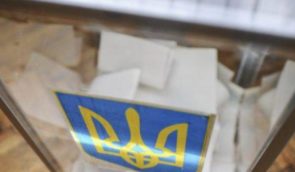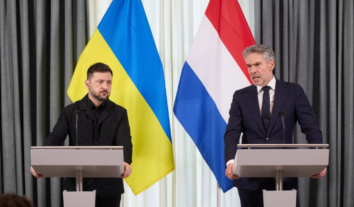The whereabouts of Azov soldier Oleh Lobov, who was severely wounded in the Olenivka terrorist attack, remain unknown
The whereabouts of Oleh Lobov, a serviceman of the “Azov” Special Forces Detachment of the National Guard, captured by Russians during the defence of Mariupol, remain unknown. His family only knows that he was evacuated from the Azovstal plant on May 17, 2022, and, after receiving treatment in a Donetsk hospital, was transferred to a penal colony. On July 28 of the same year, the Azov soldier was in the Olenivka colony barracks where the terrorist attack occurred, sustaining severe injuries. His wife, Anna Lobova, explained this information with ZMINA.
 Image: Oleh and Anna Lobovi. Photo: Anna Lobova’s Facebook
Image: Oleh and Anna Lobovi. Photo: Anna Lobova’s FacebookOn February 24, 2022, Lobov informed his wife that the “Azov” fighters would defend Mariupol. Due to poor communication, the couple rarely spoke. Sometimes, Oleh had to call his wife on an open line to let her know he was OK. He also constantly inquired about their newborn daughter, whether they had enough food, and if they had everything they needed.
“He knew that during the occupation, we weren’t in Mariupol and didn’t have baby food. That is, we had money, but you couldn’t buy anything. Everyone was struggling then, but neither I nor he complained. During the defence of Mariupol, there was complete uncertainty, and it was unclear who to ask for information,” Anna recalled.
Between April 14 and 15, 2022, Lobov contacted his wife when the Mariupol garrison fighters were breaking through to Azovstal. His twin brother died during the river crossing. After that, Anna received news from her husband even less frequently.
“We got almost all the information from the news or our small family chat. It was painful to watch the plant where your husband was staying being shelled. Of course, you had to be strong to take care of the child,” she said.
On May 17 of that year, Lobov messaged his wife, telling her that he embraced her and their daughter tightly, but said nothing about leaving Azovstal. Anna learned about it from television news and a post in the family chat.
“One of the wives of the fighters wrote in the chat that someone had informed her that they should expect an address from ‘Redis’ (Denys Prokopenko, NGU Colonel – Ed.), stating that the guys would be held in a ‘grey zone.’ That they would all call us when they arrived, and that we would be together soon. I don’t know who wrote that to her, but she did indeed spread it,” Lobova recounted.
After reading this, she began asking others what a “grey zone” was, and it surprised her that the defenders were supposed to be caught between two fires. When the occupying forces released videos of the fighters leaving Azovstal, their wives hoped it was an evacuation. However, Lobova already understood then that it was captivity.
“I saw in the video when our guys were coming out that they were being searched. But I had hopes that they would finally stop bombing them and that they would be fed. I believed that there were agreements articulated by the parties and that they would be honoured. That they wouldn’t just go into captivity because they knew what might await them there,” the prisoner of war’s wife recalled.
On July 29, 2022, while under occupation, Anna accidentally saw news on Russian television about an explosion in Olenivka that killed many people. She wrote about it in the family chat, but other women replied that it could be a hostile information psychological operation (IPSO). However, when the Russians began to release horrific footage of body remains, she realised it might be true.
At the same time, released prisoners who had been held in Olenivka stated that no one had been held in the premises where the explosion occurred, as it was an industrial zone. Therefore, Ukrainian prisoners of war could not have been there.
“We calmed down a bit until lists of the dead and wounded appeared overnight. My husband was on both. It was written that he hadn’t made it to the hospital. I had various thoughts then. I convinced myself that everything would be fine. I looked for Oleh in the videos the Russians were posting. I saw in one video that he was lying in a Donetsk hospital. I took a screenshot and sent it to my relatives. He was very thin and exhausted. The next day, I watched the video in full; powerful explosions could be heard on it. I realised that they were in danger, even in the hospital,” the wife recounted.
From conversations with released fighters, she learned that in late 2022 or early 2023, the Azov soldiers were transferred from the hospital to a penal colony. After that, almost a year passed with no information about them.
In the summer of 2024, released prisoners began contacting Lobova, telling her they had seen her husband. She also noticed that his location in the Coordination Headquarters’ personal account had changed.
In July 2024, Russians filmed a movie with Oleh’s participation, during which he was allowed to call his wife.
“That was our only communication during his entire captivity. I managed to tell him enough so he would understand where we were. At least he knows we are alive and well. I wrote to him about it in a letter that they didn’t deliver. I showed him our child, who was already two and a half years old. But she got scared by the unfamiliar voice and cried. The Russians posted all of that without cutting it,” Lobova said.
On July 26, 2024, representatives of the “Olenivka Community” held a briefing at Ukrinform. During the briefing, they showed videos recorded by Russians featuring their relatives. In the video, Azov soldiers appealed to the Ukrainian leadership for their exchange.
“Some accused us then of promoting Russian propaganda, but we were merely supporting our guys’ appeal. Although there were provocative interview titles and questions, they responded to them with dignity. They know that command has returned and expect to be exchanged as well,” Anna explained.
On February 5, 2025, one of the released prisoners informed Anna via social media that they had been moved again.
After a one-day hunger strike in central Kyiv, Anna expected that their relatives, who survived the Olenivka terrorist attack, would be returned during a “1000 for 1000” exchange. Unfortunately, this did not happen.
“The government must finally adopt Draft Resolution No. 10188 by the third anniversary of the Olenivka terrorist attack on July 28, 2022. We want to see results. We are currently awaiting a meeting. A month has already passed since our hunger strike on Maidan. We believed we were heard and that our issues would start to be resolved, but it turned out not to be the case. We will not give up, because we have no right to. We will continue to fight for our loved ones and their release,” she remarked.
As is known, Ukrainian and foreign experts have reconstructed the chronology of events at the Olenivka colony almost minute by minute on the night of July 28-29, 2022. Eyewitness testimonies and materials from journalistic investigations assisted them in this.
In July 2022, the penitentiary institution’s administration hastily began converting one of the production workshops into a barracks. On July 27, the occupying forces brought mattresses and pillows into the premises throughout the day, although it was not yet ready for occupation. On July 28, approximately 200 Ukrainian defenders were moved to these barracks, where even the sleeping arrangements were not properly equipped. The beds were placed so densely that it was only possible to move sideways between them. This contributed to a large number of injured prisoners being unable to escape the burning barracks.
On the evening of July 28, 2022, during the formation of prisoners of war, a man with the call sign “Okhotnik” was present, whose identity could not be established. With his appearance, the abuse and torture of Ukrainians intensified.
On the same day, the guards left the barracks, and Ukrainian defenders were forbidden to leave the premises. They were overseen by a duty officer from among the prisoners of war.
Around 11:00 PM – 11:30 PM, the defenders heard a “Grad” multiple rocket launcher operating in the immediate vicinity of the colony. At the same time, two explosions occurred in the barracks. Most of those interviewed believe that the “Grad” shellings were not coincidental and were intended to muffle the sounds of the explosions in the barracks.
Human rights advocates assert that the nature of the damage to the barracks and the injuries sustained by the prisoners of war indicate explosions, most likely the result of a thermobaric weapon, such as a “Shmel” rocket-propelled flamethrower. The explosion caused such a severe fire in the building that the temperature at the epicentre of the explosion could have reached 1,500 degrees Celsius. As a result of the explosion, at least 53 prisoners died, nine of whom succumbed due to a lack of timely medical assistance.
At that time, the colony administration prohibited ambulances that arrived at the scene from entering its territory. The occupying forces also forbade Ukrainian military medics, who were held in the Olenivka colony, from providing aid to the injured.
By way of background, on July 29, 2022, following the night-time Russian terrorist attack, representatives of the Prosecutor General’s Office entered information into the Unified Register of Pre-trial Investigations regarding the shelling by the Russian military of the former correctional colony in the settlement of Olenivka, the Donetsk region, under the signs of a criminal offense stipulated by Part 2 of Article 438 of the Criminal Code of Ukraine – violation of the laws and customs of war.
During the pre-trial investigation, employees of the Main Investigative Department of the SBU conducted a comprehensive examination of the weapon, its traces, and the circumstances of its use. According to the expert conclusion, the explosion on the colony’s territory was caused by the use of a reactive thermobaric grenade launcher.
The Prosecutor General’s Office informed that, based on the results of conducted forensic molecular-genetic examinations, 33 individuals among those killed in the Olenivka explosion on the night of July 28-29, 2022, whose bodies were successfully returned to Ukrainian-controlled territory, have been identified.
The identification of another 24 returned bodies, who might have been in this colony, is ongoing.
Additionally, among those returned to Ukrainian-controlled territory, 13 servicemen—former prisoners of the colony where the explosion occurred—were interviewed as victims.
The SBU announced suspicions against two citizens of Ukraine—Serhiy Yevsiukov and Dmytro Neiolov—who held positions as head and first deputy head of the institution created by the “DPR” group based on the colony. They are accused of cruel treatment of prisoners of war, combined with premeditated murder committed by a group of persons by prior conspiracy (Part 2 of Article 28, Part 2 of Article 438 of the Criminal Code of Ukraine). The SBU also stated that in November 2022, both occupiers were removed from their “positions,” and they are currently hiding in the temporarily occupied part of the Donetsk region.
On July 11, 2023, a petition was published on the President’s website requesting the establishment of national days of mourning and remembrance for the defenders executed as a result of the terrorist attack in colony No. 120 in the urban-type settlement of Olenivka. It was initiated by Maria Alekseevich, a representative of the public organisation “Olenivka Families Community.” The petition garnered over 25,000 votes, but there has been no presidential response yet.


